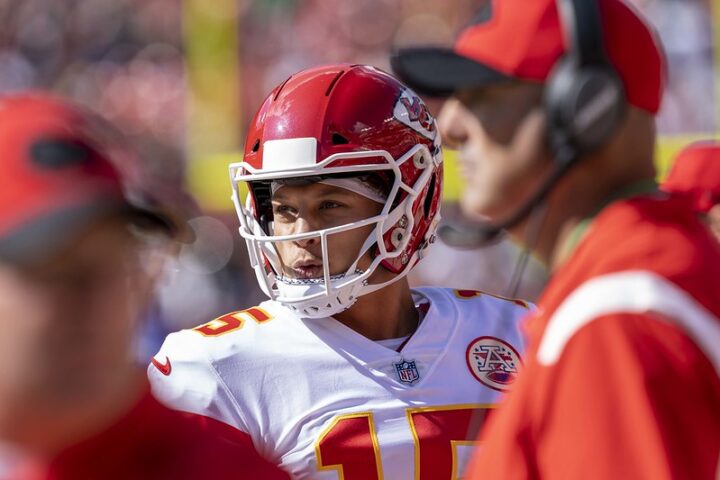An under-the-radar Heisman candidate after his strong start to the 2022 campaign, Tennessee QB Hendon Hooker is looking to make a name for himself and bolster his scouting report ahead of the 2023 NFL Draft. In a class that’s wide open after C.J. Stroud and Bryce Young, can Hooker become a factor?
Hendon Hooker NFL draft profile
It’s been a long and winding road for Hooker, who was at one point a simple footnote in modern college football history. The former four-star recruit and sixth-year senior began his collegiate career at Virginia Tech, where he redshirted in 2017. He’d sit as a backup in 2018, then emerge as a quality starter during the 2019 season.
Hooker provided some stability at QB under head coach Justin Fuente, particularly in 2019. That year, Hooker completed 99 of 162 passes for 1,555 yards, 13 touchdowns, and two interceptions. But things soured in 2020, and soon after, Hooker transferred to Tennessee to get a fresh start. He got that and more in Knoxville.
Hooker was a breakout star in 2021. In his first year with Josh Heupel, Hooker completed 206 of 302 passes for 2,945 yards, 31 touchdowns, and just three interceptions. His level of efficiency was near unparalleled, and he’s carried it over into 2022.
Through four games, Hooker’s Volunteers are 4-0. Hooker has completed 71.7% of his passes, averaging 10.6 yards per attempt, and has eight touchdowns to no picks. He’s also added three scores on the ground.
Hooker’s rise with the Volunteers has many pondering his 2023 NFL Draft projection. With the production in mind, let’s turn to the traits and see what he can provide.
- Position: Quarterback
- School: Tennessee
- Current Year: Redshirt Senior
- Height/Weight: 6’4″, 218 pounds
Hendon Hooker Scouting Report
Does Hooker have the skills to potentially challenge for early-round billing in the 2023 NFL Draft? Let’s take a closer look.
Hooker’s Positives
At 6’4″, 218 pounds, Hooker has great height and weight for the QB position, and it’s reasonable to project some durability with that frame. Hooker passes the prototypical QB eye test, and he also has a lot of the desired physical traits.
Hooker has great arm strength. The Tennessee QB can generate solid amounts of velocity with relative ease on a crisp, slingshot release. He brings great velocity generation in the short and intermediate ranges, and maintains a tight spiral.
To that end, he doesn’t appear strained when generating velocity in those ranges. He has the arm strength to fit the ball into tight pockets outside the numbers with pace.
Going a step further, Hooker’s arm is both strong and noticeably elastic. He’s shown he can mix pace and touch on his throws to a degree. He’s not a purely linear thrower and can drop passes into buckets after launching with good velocity.
Hooker has the elasticity to layer throws over defenders with velocity as well. Moreover, he can adjust throwing angles to a degree and generate ample velocity off-platform.
Hooker’s arm elasticity and strength, combined with his athleticism and size, grant him exciting creation capacity. With his size, he can slip through sacks and stay on his feet, and he has the athleticism to create beyond that.
The Tennessee QB has exceptional short-area burst, as well as solid speed when he hits open space. Additionally, he shows off impressive short-area twitch and foot speed for his size. Hooker can levy quick cuts and make single defenders miss, and can immediately generate momentum in congestion.
Expanding on Hooker’s creation capacity, the Tennessee QB shows glimpses of impressive creative instincts, with which he can maximize his traits. Hooker can keep his eyes up as a scrambler and take advantage of late windows on plays.
In a similar vein, he has an awareness of how his ability as a runner can draw defenders in. He’ll actively attempt to manipulate defenders and hit open WRs shortly after.
Hooker’s off-platform ability helps solidify his off-script utility. He’s shown he can effectively torque his hips off-platform, even when rolling to his left. In these scenarios, Hooker flashes the ability to keep his shoulders level on the run and maintain accuracy.
Moreover, the Tennessee QB can sidestep rushers and effortlessly re-torque his hips to hit WRs on the scramble drill. And as a runner, he’s shown he can use blockers to extend runs and manipulate defenders in space.
As a processor, there are still questions Hooker has to answer. However, there are some positives to note in this department. Though he’s not a progression thrower, Hooker has shown he can anticipate second-window throws and trigger as receivers pass behind defenders.
In that regard, he flashes quick processing and reaction to stimulus. He’s also flashed the ability to read hi-to-low and has shown he can process and react quickly to broken coverages.
One of Hooker’s hallmarks at Tennessee has been his general accuracy. While he still has room to improve in this area, he does have a level of baseline accuracy. Particularly when he’s mechanically sound, Hooker can hit receivers in the torso with great velocity in the short and intermediate ranges, and he’s shown he can place passes that only receivers can reach.
Going further, Hooker has shown he can effectively adjust the trajectory of his throws and place back-shoulder throws on the sideline. To a degree, he’s shown he can anticipate and lead receivers away from contact, hit WRs in-stride over the middle of the field with velocity, and give his teammates a chance on deep throws.
In the pocket, Hooker has shown he can remain composed and stay in-phase in the pocket while surveying windows. He’s poised at top of the drop and willing to stand in condensed spaces more often than not.
Beyond that, Hooker flashes tremendous instincts in tight spaces. He has a good feel of when to escape the pocket and has good awareness of his outlets, and can also sense pressure on the backside and find his check-down.
Taking it a step further, Hooker can sense rushers looping around, roll his shoulder to avoid contact, and roll up into open lanes.
Mechanically, Hooker has shown he can square up his base to load and torque his hips ahead of throws. He’s also shown he can snap into phase ahead of throws and correct his base quickly, and plant his front foot accurately in the process.
Moving to his upper body, Hooker does have enough mechanical control to use subtle manipulations of shoulder alignment to adjust the trajectory of his throws and fit the ball into tight pockets with loft.
Rounding out Hooker’s strengths, the Tennessee QB has shown discretion at times when passing up first-window throws and waiting for the second window on slants and digs. He also shows this window awareness off-script.
Going further, Hooker flashes the necessary discretion to land on his check-down after progressing hi-to-low and sensing pressure. And as a competitor, he’s willing to finish forward on runs and use his frame against defenders.
Hooker’s areas for improvement
Physically, Hooker has a great foundation, but his arm isn’t quite elite. The Tennessee QB doesn’t consistently generate elite velocity on his throws, nor does that velocity consistently carry through to the deep range.
He’s also not quite an elite athlete. He has great athleticism for size, but he’s more of a linear runner, and not an overwhelming lateral threat in space.
Of course, Hooker’s physical tools remain one of his top selling points. Meanwhile, one of his top concerns is his processing and overall lack of progression work. Hooker is relatively reliant on scripted, one-read plays and RPO’s, and will at times predetermine throws and force passes in tight coverage. He also struggles with eye discipline and will need to improve this at the next level.
Hooker sometimes hesitates and stares down targets before releasing, and his eyes can draw defenders in early. He’s late to trigger on comebacks more often than desired, and he needs to more often anticipate breaks. To that end, Hooker will sometimes increase the risk factor of a throw with delays between recognition and release.
His frozen eyes can close windows quickly when staring down targets. He doesn’t have a great grasp of eye manipulation. And when he does have chances to go through progressions, he’s relatively slow progressing from read to read.
Expanding on his errors as a processor, indecision sometimes sets in for Hooker when delays in reaction close windows. This can set off a domino effect that collapses plays. He’ll also sometimes trigger on open receivers far too late, even after a second of drawing defenders in.
Overall, Hooker’s struggles with eye discipline and independent processing reduce his margin of error for precision, especially over the middle of the field. This makes Hooker’s issues with precision all the more worrying because, at this point, he’s not consistent enough of a processor to offset them. For a player who’ll be a 25-year-old rookie, that is a concern.
At times, Hooker’s precision on short RAC throws can improve. He sometimes throws high and leads WRs into contact when he should place for space efficiency. This inaccuracy too often forces adjustments from receivers in the short range on RAC passes. Mechanical inconsistencies can give way to this periodic inaccuracy — often high in the short and intermediate ranges.
But what mechanical flaws lead to this inaccuracy? For Hooker, it’s a mix of lower and upper-body issues. He sometimes appears to have more of an overhead release, as opposed to a rotational release.
This can push passes high and cause volatility at times. In a similar vein, Hooker’s release can be a bit concentric and concave. This circular motion can cause variation in his release point and disrupt throw trajectories.
Additionally, with his overhead release, Hooker sometimes tips his front shoulder up ahead of throws, causing passes to sail. His base can be unsteady on release, causing his shoulders to misalign high and low at times.
This stems from inconsistencies with his footwork. Hooker can more consistently plant and roll his hips through throws to stabilize his trajectory and maximize velocity output. When he doesn’t roll through, his lower body is neutralized, and he doesn’t benefit from full rotation.
Moving elsewhere, Hooker can sometimes better play to receiver leverage and lead receivers away from contact in the intermediate range. Meanwhile, in the pocket, Hooker can better use hallways to step up and drive his hips through throws.
He sometimes floats at top of his drop and doesn’t use space effectively. Furthermore, Hooker’s pressure detection can be hot and cold at times. He sometimes flees too early and sometimes fails to detect backside rushers.
Among other things, Hooker sometimes freezes in the pocket when reading breaks, which can leave him vulnerable to quick pressure. He can better stand in and deliver amidst contact at times, as pressure can cause him to clutch throws and hesitate.
Current Draft Projection for Tennessee QB Hendon Hooker
Hooker’s strong play at Tennessee has forced many to take a closer look at his profile and how he projects. At the moment, he still grades out in the early-to-mid Day 3 range. He’s not quite a first-round candidate, but he’s undoubtedly a draftable quarterback prospect with enough physical upside to be worth a stash in an NFL QB room.
With Hooker, there will always be a slight disconnect between his statistical production and his operational ability on tape. Hooker assuredly has enough active discretion to work in timing and RPO offenses.
But there’s a startling lack of full-field progression work on the film, and his lack of eye discipline is something that could invite risk at the NFL level, where defenses are more disciplined.
There are flashes of translatable mental qualities with Hooker. He has great creative instincts as a runner, to go along with his size and athleticism. He’s also flashed anticipation on second-window throws over the middle of the field and has some awareness of defender manipulation when playing off-script.
Hooker’s tools alone are starter quality. But as we’ve seen, it takes much more than that to be an NFL starter. At 25-years-old, it’s hard to say that Hooker can develop enough in other areas.
But at the very least, he’s worth an early-to-mid Day 3 pick as a developmental backup. His physical tools alone provide a buffer amidst adversity — a valued quality in a backup. And in such a role, he’d have time to keep refining his mental game.



